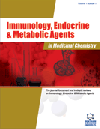- Home
- A-Z Publications
- Immunology, Endocrine & Metabolic Agents in Medicinal Chemistry (Formerly Current Medicinal Chemistry - Immunology, Endocrine and Metabolic Agents)
- Previous Issues
- Volume 15, Issue 2, 2015
Immunology, Endocrine & Metabolic Agents in Medicinal Chemistry (Formerly Current Medicinal Chemistry - Immunology, Endocrine and Metabolic Agents) - Volume 15, Issue 2, 2015
Volume 15, Issue 2, 2015
-
-
Immune-Neuroendocrine Interactions Involving Thymus and Pineal Gland in Stem Cell Therapy of Age-Related Diseases
More LessRise in the frequency of age-related diseases (neurodegenerative and cardiovascular diseases, osteoporosis, etc.) has great socio-economic implications. Great pathogenetic significance of age changes in functioning of the immune and neuroendocrine systems and their relationship with dysfunction of the central organs (thymus and pineal gland) has been established. On the contrary, melatonin and thymic hormones not Read More
-
-
-
Application of Mesenchymal Stem Cells to Age-related Neuronal Diseases
More LessAdult stem cells and their potential in clinical applications have been intensively investigated in the past decade. Mesenchymal stem cells (MSCs) represent adult tissue stem cells: Bone marrow, cord blood, umbilical cord, and recently, adipose tissues are used as major sources of MSCs. Because of less ethical concerns as well as easier cell culture to propagate, MSC-based therapies sound promising for clinical settings. S Read More
-
-
-
Potential of Unengineered and Engineered Wharton’s Jelly Mesenchymal Stem Cells as Cancer Inhibitor Agent
More LessCancer is one the most common life-threatening diseases. Cancer cases worldwide are forecast to rise by 75% in the future. Although cancer therapies have been improved, many tumors remain unresponsive to conventional treatments, such as radiation and chemotherapy. Therefore, novel strategies in treating and managing the disease are urgently needed. Wharton's Jelly-derived mesenchymal stem cells (WJ-MSCs) Read More
-
-
-
Promises and Challenges of Adult Stem Cells in Cancer Therapy
More LessAuthors: Vincenzo Eterno, Alberto Zambelli, Lorenzo Pavesi and Angela AmatoThe discovery of adult stem cells represents a milestone for the last decade research, due to their potential use in the field of regenerative therapy. Adult stem cells exist in all human tissues because they support tissue homeostasis and help in renewal and healing processes. Similar to human Embryonic Stem Cells (hESCs), adult stem cells are able to self-renew and differentiate into specialized cells of different embryonic germ Read More
-
-
-
Adipose Tissue and Bone Marrow as Sources for Cell-based Therapeutic Angiogenesis in Ischemic Tissues: Biological Foundation and Clinical Prospects for Age-related Vascular Disease
More LessAuthors: Dmitry Bulgin and Enes HodzicIt is well established that aging is a significant risk factor for homeostatic imbalance, decline in vascular regenerative capacity and development of vascular disease with progressive organ dysfunction. Over the past decade therapeutic developments have improved the prognosis for those with vascular disease, mortality rates have nevertheless remained actually unchanged. Clearly, there is a need for alternative strategies for t Read More
-
-
-
Ingestion of Salmon Nasal Cartilage-Derived Proteoglycan Improves Skin Condition: A Randomized, Double-Blind, Controlled Study
More LessBackground: Proteoglycan is one of the components of the extracellular matrix with various biological activities and has been used as the functional foods to improve knee joint health or skin condition. Objective: To examine the effect of ingestion of salmon (Oncorhynchus keta, Salmonidae) nasal cartilage-derived proteoglycan (sPG) on skin condition, we performed a randomized, double-blind, controlled study in healthy adult volun Read More
-
-
-
An Engrossing History of Azidothymidine
More LessAuthors: Vivek K. Sharma, Raman K. Sharma, Pramod K. Singh and Sunil K. SinghAzidothymidine (AZT) was the first breakthrough drug developed for the treatment of acquired immunodeficiency syndrome (AIDS). It took AZT only 25 months from the first successful laboratory activity against human immunodeficiency virus (HIV) to its approval by the FDA. Similar interesting facts and disputes have persistently been associated with AZT starting from its very first synthesis to the development and a Read More
-
Most Read This Month
Article
content/journals/iemamc
Journal
10
5
false
en


